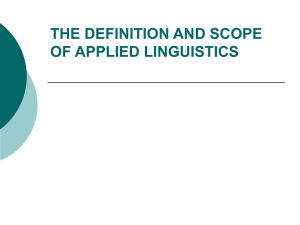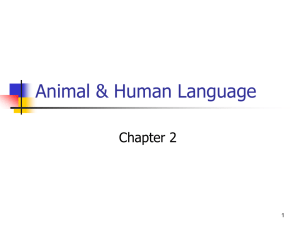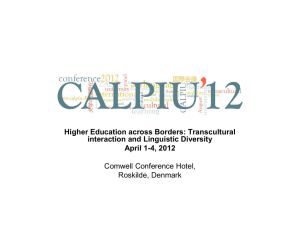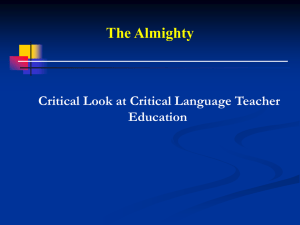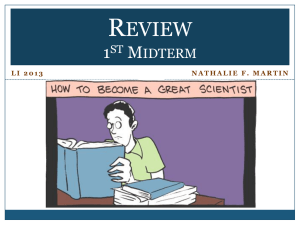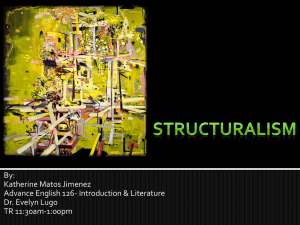1. Course title: English 611: Terminology in Linguistics and
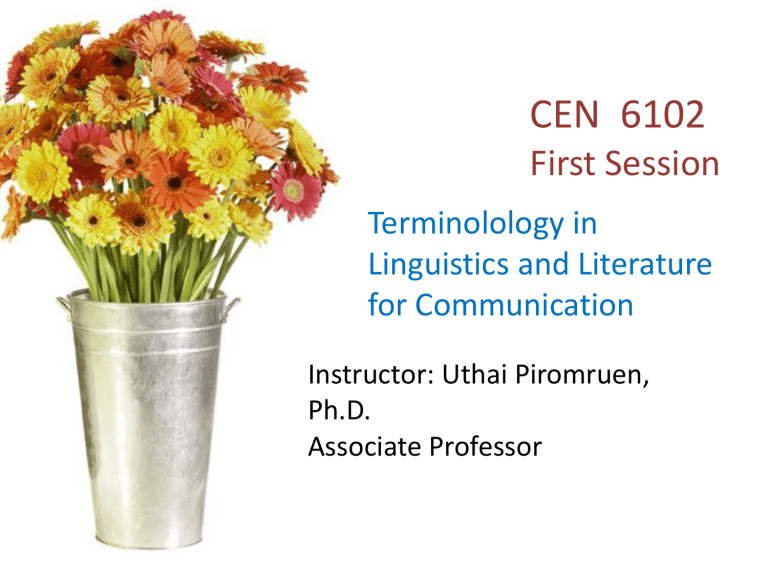
English 611
CEN 6102
• Terminology in Linguistics and First Session
• Literature for Communication
Linguistics and Literature
• Instructor: Uthai Piromruen, Ph.D.
• Associate Professor
Ph.D.
Associate Professor
First Session
• Orientation to the Course
• Introduction to Language & Linguistics
• 1. Definition of Language
• 2. The origins of language
• 3. Universal properties of language
• 4. Animals & human language
• 5. The diversity of linguistics
Orientation to the Course
• 1. Course title: English 611: Terminology in
Linguistics and Literature for Communication
• 2. Class schedule: Sunday 1-4 pm.
• 3. Room: POTDUANG, Humanities Building #1
• 4. Instructor: Uthai Piromruen, Ph.D.
• Associate professor
• 5. Weekly Assignments: Group/individual study project/questions
• 6. Evaluation: Written Test:Midterm 30% Final
30%, Group/individual Report 30%, Attendance
10%, Grade: S, U: S=Satisfactory, U=Unsatisfactory
Orientation to the Course
• 1. Course title: CEN 6102 : Terminology in
Linguistics and Literature for Communication
• 2. Class schedule: Saturday 1-4 pm.
• 3. Room: AV, HUMBuilding N0#1.
• 4. Instructor: Uthai Piromruen, Ph.D.
• Associate professor
• 5. Weekly Assignments: Group/individual study project/questions
• 6. Evaluation: Written Test:Midterm 30% Final
30%, Group/individual Report 30%, Attendance
10%, Grade: S, U: S=Satisfactory, U=Unsatisfactory
Study Project/Question #1
How to set up your project
• Select the topic for your study project based on the topics presented in this first session.
• Organize a group of three students.
• Choose your group leaders and members.
• Write down the topic you selected for your group.
• Search for more new information from the sources.
Questions # 1
• 1. Why human languages are so much different from one another?
• 2. Why words can have many meanings?
• -List some of them.
• 3. Can animals learn a human language?
• 4. What branches of linguistics are influencial in today’s living?
1.Introduction to Language &
Linguistics
Definition of Language
• “A finite system of elements and principles that make it possible for speakers to construct sentences to do particular communicative jobs”
(Fasold & Connor-Linton, 2006. p. 9, adapted from Finegan and Besner (1989).
2. The origins of language
• 1. The divine source
• 2. The natural-sound source
• 3. The oral gesture source
• 4. Glossogenetics
• 5. Physical adaptation: the human teeth, lips, mouth and tongue, the human larynx, pharynx, the human brain is lateralized
• 6. Interactons and transactions
3. Universal properties of language
• Modularity
• Constituency and recursion
• Discreteness
• Productivity
• Arbitariness
• Reliance on content
• Variability
• (Fasold and Connor-Linton, 2006, pp.1-7)
5. The Diversity of Linguistics
1.6 What is Linguistics?
• Linguistics—A scientific study of language .
• The systematic inquiry into human language—into its structures and uses and the relationship between them, as well as into the development and acquisition of language
The scope of linguistics
• Includes both language structure
(and the grammatical competence underlying it)
• And language use (and its underlying
Communicative competence)
The branches of linguistics.
• Historically, the central focus of language study has been grammar—patterns of speech sounds, word structure, sentence formation, and meaning.
• More recently, attention has also focused on the relationship between expression and meaning, and context and interpretation, which is called Pragmatics
Other branches of Linguistics
• Language variation across speech communication or within a single community, across time and across situations of use. It seeks two kinds of explanation—cognitive ones—the human language-processing and the
social ones--social interaction and the organization of societies
The third group of linguists
• Applies the findings of the discipline to realworld problems in Educational matters, to the acquisition of literacy (reading and writing) and of second languages and foreign languages; in clinical matters, to understanding aspects of Alzheimer’s disease and aphasia; in forensic settings , to analyze the conversation for evidence of conspiracy and others for legal matters, in language policies for cross-cultural communication
Linguistcs Disciplines
• Theoretical Linguistics:
• -Phonetics, Phonology, Syntax,
• Semantics, Language acquisition,
• Applied Linguistics:
• -Psycholinguistics
• -Sociolinguistics
• -Neurolinguistics
• -Anthropological linguistics
• -Historical linguistics
• -Pragmatics
• -Computational linguistics
Questions # 2
The sounds of language
• 1. What is articulatory phonetics?
• 2. How are speech sounds made?
• 3. How many different sounds do languages use?
• 4. How does sound travel through the air?
• 5. How is it registered by the ears?
• 6. How can we measure speech?
